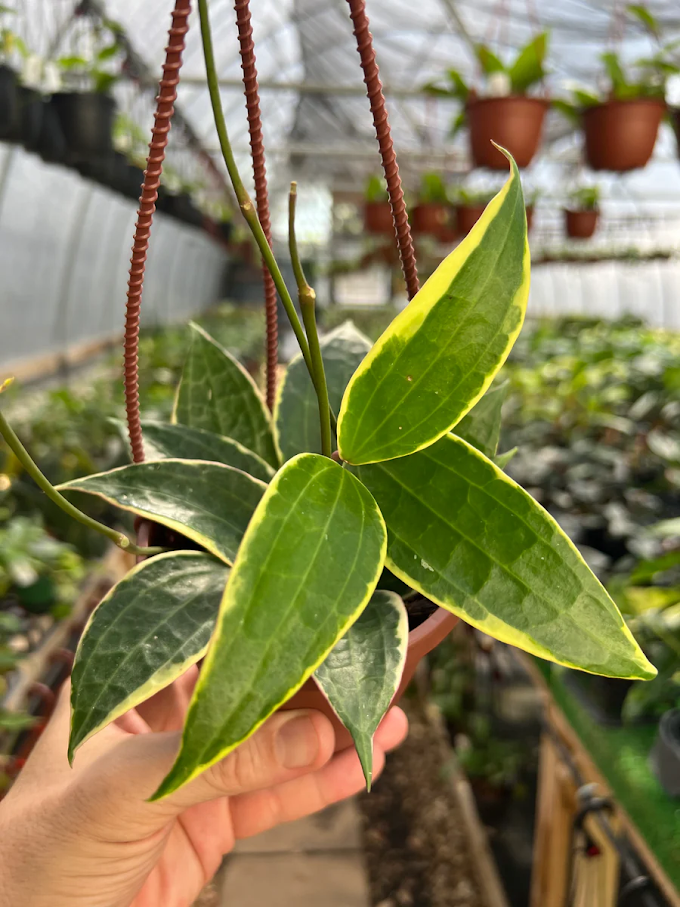Hoya latifolia: The Bold Beauty of the Wax Plant World
%20variegated%20hanging%20basket.jpg) Images @oiqycom
Images @oiqycom
Among the world of houseplants and tropical flora, the genus Hoya has garnered a devoted following for its elegant vines, waxy foliage, and mesmerizing floral displays. While popular species like Hoya carnosa and Hoya pubicalyx often take the spotlight, there exists a lesser-known yet equally captivating species—Hoya latifolia. With its broad, bold leaves and fragrant clusters of star-like flowers, Hoya latifolia is an extraordinary plant deserving of attention, both from collectors and casual plant lovers alike.
In this article, we’ll explore the origins, appearance, growing requirements, propagation techniques, and the unique appeal of Hoya latifolia, uncovering why it is not just another wax plant, but a tropical marvel that commands space and admiration.
Origins and Taxonomy
Hoya latifolia is native to Southeast Asia, particularly found in regions such as Malaysia, Thailand, and parts of Indonesia. The name “latifolia” itself comes from Latin roots—“latus” meaning broad, and “folium” meaning leaf—aptly describing the plant’s standout feature: its impressively wide leaves.
This species belongs to the Apocynaceae family and is a member of the Hoya genus, which comprises over 500 species. The genus was named in honor of Thomas Hoy, a gardener to the Duke of Northumberland in the 18th century. Hoyas are often referred to as “wax plants” due to their thick, glossy foliage and flowers that appear as though they are sculpted from wax.
Interestingly, Hoya latifolia has undergone taxonomic debates over the years, sometimes confused with or considered a variation of Hoya macrophylla due to their morphological similarities. However, modern classifications typically recognize H. latifolia as its own distinct species.
Botanical Description
The most immediately striking feature of Hoya latifolia is its foliage. The leaves are large, oval-shaped, and deeply veined, with a leathery texture and a semi-glossy surface. They can reach up to 15–20 cm in length and 10–12 cm in width, making them some of the broadest in the Hoya genus.
New leaves emerge with a reddish hue before maturing into a deep green. Variegated forms of H. latifolia also exist, boasting creamy margins or central stripes, adding an extra layer of appeal for collectors.
The flowers of Hoya latifolia are another marvel. Blooming in clusters known as umbels, the individual flowers are typically cream to pale pink in color with a central corona that ranges from yellow to reddish hues. Their scent is sweet and pleasant, especially at night, a trait likely evolved to attract nocturnal pollinators like moths.
Unlike some Hoyas that flower freely even in small pots, H. latifolia may require more maturity and patience. However, when it does bloom, the display is truly spectacular.
Growing Conditions
Despite its tropical origins, Hoya latifolia is relatively adaptable, provided it is given conditions that mimic its native habitat. Here’s what it takes to keep this plant thriving:
1. Light Requirements
Bright, indirect light is ideal. While H. latifolia can tolerate some direct morning sun, harsh afternoon rays can scorch its leaves. Under low-light conditions, the plant may grow more slowly and become leggy, and flowering is unlikely.
2. Temperature and Humidity
Being a tropical species, H. latifolia thrives in warm, humid environments. Ideal temperatures range from 18°C to 30°C (65°F to 86°F). Humidity levels above 60% are optimal, but it can adapt to slightly lower levels with regular misting or the use of a humidifier.
3. Soil and Potting
Like other Hoyas, H. latifolia prefers a well-draining, aerated mix. A typical soil mix might include orchid bark, perlite, coco coir, and a bit of potting soil or compost. The goal is to retain some moisture without becoming soggy, which could lead to root rot.
4. Watering
Watering should be moderate and adjusted based on the season and environment. Allow the top few centimeters of soil to dry out between waterings. Overwatering is one of the most common mistakes with Hoyas, especially with their thick, water-retentive leaves.
5. Feeding
During the growing season (spring and summer), feeding monthly with a balanced liquid fertilizer can promote healthy growth and encourage blooming. Reduce or eliminate feeding during the dormant winter months.
Propagation Techniques
Hoya latifolia can be propagated through stem cuttings, the most common method used by hobbyists and growers.
-
Cut a Healthy Stem: Choose a section with at least two nodes.
-
Remove Lower Leaves: This prevents rotting when submerged in water or soil.
-
Rooting Medium: Cuttings can be placed in water, sphagnum moss, or a light potting mix.
-
Warmth and Humidity: Keep the environment warm and humid. A propagation box or plastic cover can help retain moisture.
-
Wait for Roots: Roots may develop within 2–6 weeks depending on conditions.
Once the roots are well established, the new plant can be potted into a small container with a proper hoya soil mix.

%20variegated%20hanging%20basket.jpg)